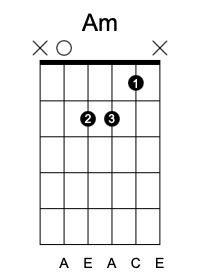Easy Intro to Major Chords
 Major chords are the foundation of Western music and are essential for any aspiring guitarist. They are characterized by their bright, happy sound. The most common major chords include C, G, D, A, and E. To form a major chord, you need the root note, the major third, and the perfect fifth.
Major chords are the foundation of Western music and are essential for any aspiring guitarist. They are characterized by their bright, happy sound. The most common major chords include C, G, D, A, and E. To form a major chord, you need the root note, the major third, and the perfect fifth.
For instance, a C major chord comprises C (root), E (major third), and G (perfect fifth). Start practicing these shapes to build your chord vocabulary.
How to Read Guitar Chords
Reading guitar chords involves understanding chord diagrams, which are visual representations of the guitar fretboard. The vertical lines represent the strings, and the horizontal lines represent the frets.
Dots on the diagram indicate where to place your fingers, with numbers often showing which fingers to use. Open strings are shown with an “O” above the diagram, while muted strings are marked with an “X”.
How to Make a Guitar Chord Chart

Am Chord
Creating a guitar chord chart is a useful way to organize and visualize chords. Start by listing the chords you want to include. Draw a series of chord diagrams, ensuring each diagram clearly shows the finger positions.
Label each chord with its name and make sure to include both major and minor chords, as well as any variations you find useful. This personalized chart will be a handy reference tool.
The 1 4 5 Chord Progression for Guitar
The 1 4 5 chord progression is one of the most popular in music, especially in blues, rock, and country genres. In the key of C, these chords are C (1), F (4), and G (5).
This progression creates a strong sense of movement and resolution, making it a staple in songwriting. Practicing this progression in various keys will improve your ability to play and recognize common song structures.
Dominant Chord Function for Guitar
Dominant chords, particularly the dominant seventh (7th) chord, play a crucial role in music by creating tension that resolves to the tonic (root) chord. For example, in the key of C, the G7 chord (G dominant 7th) resolves to the C major chord.
Understanding and utilizing dominant chords will enhance your ability to create dynamic and interesting chord progressions.
Top Tips to Play Guitar Chords
- Finger Placement: Ensure your fingers are pressing down on the strings close to the frets to avoid buzzing.
- Hand Position: Keep your thumb behind the neck for better reach and control.
- Practice Transitions: Work on smoothly transitioning between chords to maintain rhythm.
- Strumming Patterns: Experiment with different strumming patterns to add variety to your playing.
- Finger Strength and Dexterity: Regular practice will improve your finger strength and dexterity, making chord changes easier.
Tips to Use Chord Triads
 Chord triads, consisting of three notes, are fundamental in creating harmonies. Practice forming major, minor, and diminished triads on different string sets.
Chord triads, consisting of three notes, are fundamental in creating harmonies. Practice forming major, minor, and diminished triads on different string sets.
Using triads up and down the neck will give you a better understanding of the fretboard and improve your ability to create melodic and harmonic lines.
Playing Barre Chords
Barre chords are essential for playing movable chord shapes across the neck. By using your index finger to press down multiple strings, you can create chords that can be shifted up and down the fretboard.
Mastering barre chords like F and B minor will expand your ability to play in any key.
Barre Chord A
The barre chord A shape is a movable chord form based on the open A major chord. To play a barre A chord, bar all the strings at a given fret with your index finger and shape an A major chord with your remaining fingers.
This shape can be moved up and down the neck to play different major chords.
The E7 Guitar Chord
 The E7 chord adds a bit of bluesy flair to the basic E major chord. It consists of the notes E, G#, B, and D.
The E7 chord adds a bit of bluesy flair to the basic E major chord. It consists of the notes E, G#, B, and D.
It can be played in open position or as a movable chord shape, and it is commonly used in blues, rock, and jazz music to create tension that resolves to the A major chord.
G Chord on the Guitar
The G major chord is one of the first chords beginners learn. It consists of the notes G, B, and D.
There are several ways to play it, but the most common involves placing your fingers on the third fret of the low E string, second fret of the A string, and third fret of the high E string, while keeping the other strings open.
Am7 Guitar Chord
The Am7 chord adds a rich, melancholic tone to the standard A minor chord. It includes the notes A, C, E, and G.
The Am7 chord is often used in jazz and blues to add depth and complexity. You can play it by simply removing your ring finger from the A minor chord shape, making it easier to transition from other chords.
The B Guitar Chord
 The B major chord is typically played as a barre chord due to its position on the neck.
The B major chord is typically played as a barre chord due to its position on the neck.
It includes the notes B, D#, and F#. The most common way to play it is by barring the second fret with your index finger and placing your other fingers on the fourth fret of the D, G, and B strings.
Cadd9 Guitar Chord
The Cadd9 chord is a variation of the C major chord with an added ninth (D). It offers a bright and open sound and is often used in folk and pop music. It is played by placing your fingers similarly to a G major chord but shifting down to start on the C note.
G/F Guitar Chord
The G/F chord, also known as G over F or G with F in the bass, adds a deeper, more complex sound to the standard G major chord. It is played by adding an F note, typically on the low E string, while holding the G major shape. This chord is useful for creating smooth bass lines in chord progressions.
B7 Guitar Chord
The B7 chord is a dominant seventh chord that adds a bluesy feel to your music. It consists of the notes B, D#, F#, and A. It is commonly played in the open position and is a favorite in blues and jazz genres for its tension and resolution properties.
The C/E Guitar Chord
 The C/E chord, also known as C major over E, adds a different bass note to the standard C major chord. It is played by including an E note as the lowest note, which can be done by playing the C major chord shape but allowing the low E string to ring out. This chord is useful for smoother bass transitions in progressions.
The C/E chord, also known as C major over E, adds a different bass note to the standard C major chord. It is played by including an E note as the lowest note, which can be done by playing the C major chord shape but allowing the low E string to ring out. This chord is useful for smoother bass transitions in progressions.
The F#m Guitar Chord
The F#m (F# minor) chord is a barre chord consisting of the notes F#, A, and C#. It is typically played by barring the second fret and forming an E minor shape. This chord is essential for playing in keys like A and E major and adds a melancholic tone to your music.
Most Common Guitar Chords
Knowing the most common guitar chords is essential for any guitarist. These include major chords like C, G, D, A, and E, minor chords like Am, Em, and Dm, and dominant seventh chords like G7 and C7.
Mastering these chords will allow you to play a wide variety of songs.
30 Most Common Guitar Chords
 A comprehensive list of the 30 most common guitar chords includes major, minor, and seventh chords across different keys. This list typically covers C, G, D, A, E, Am, Em, Dm, F, Bm, B, and various seventh chords.
A comprehensive list of the 30 most common guitar chords includes major, minor, and seventh chords across different keys. This list typically covers C, G, D, A, E, Am, Em, Dm, F, Bm, B, and various seventh chords.
Learning these chords will provide a solid foundation for playing most popular music.
Best Guitar Chords for Beginners
For beginners, focusing on the 20 best guitar chords is crucial. These include basic open chords like C, G, D, A, E, Am, Em, and Dm.
These chords are easy to learn and form the basis of many songs, making them perfect for building your initial chord repertoire.
Jazz Chords for Guitar
Jazz guitarists often use more complex chords to create rich, textured sounds. Eight powerful jazz chords to learn include major 7th, minor 7th, dominant 7th, diminished 7th, half-diminished, augmented, 9th, and 13th chords. These chords will add depth and sophistication to your playing.
Guitar Chord Finder
A guitar chord finder is an essential tool for any guitarist, helping you to quickly find and learn new chords.
These tools often include diagrams and audio samples, making it easier to understand and play a wide range of chords. They are invaluable for expanding your chord knowledge and improving your playing.
